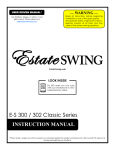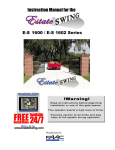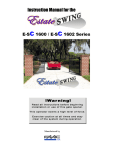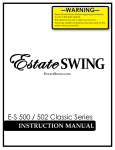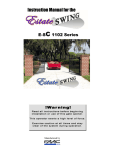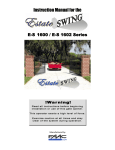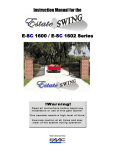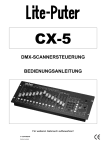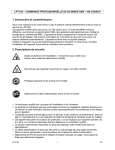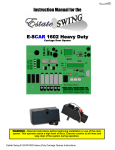Download Estate Swing Instruction manual
Transcript
EstateSwing.com Plug-in Option E-S 1000D Series INSTRUCTION MANUAL Estate Swing Summary of Functions The Estate Swing is only to be used for vehicular swing gates in a Class I setting. Class I: A vehicular gate opener (or system) intended for use in a home of one-to-four single family dwelling, or a garage or parking area associated therewith. The Estate Swing automated system was designed and built for controlling vehicle access. Do not use for any other purpose. The external automation with an electromechanical non-reversing linear arm automates residential dual swing-leaf gates with leaves of up to 12’ in length per leaf. It consists of an irreversible electromechanical operator with built in opening and closing limits and utilizes a worm screw system. The irreversible system ensures the gate is mechanical locked when the motor is not operating. A lock still needs to be installed if security or high winds are a concern. Removal of the gate slide pin will manually allow the gate to be opened. For Your Assistance Keep this manual safely stored after installation Serial Number ________________________________ Date of Purchase _____________________________ Place of Purchase ____________________________ Have this information on hand while handling all service and warranty issues. E-S 1000D Series Instruction Manual Table of Contents The table of contents are listed to assist you locating a desired section. We do however strongly suggest studying every page of the instruction manual before attempting installation. Section 1: Review of Specifications, Warnings, and Tools Specifications of the Estate Swing and Components Parts List System Overview & Preliminary Checks Tools Needed for Installation 1.1 1.2 1.3 1.4 Section 2: Installation of Mounting Brackets Manual Operation Pull to Open Illustration IMPORTANT: Determining Setback—Pull to Open Installation of Operator—Pull to Open Push to Open Illustration IMPORTANT: Determining Setback—Push to Open Installation of Operator—Push to Open 2.1 2.2 2.3 2.4-7 2.8 2.9 2.10-13 Section 3: Gate Operator Mounting, Wiring Motors and Power Mounting Gate Operator(s) & Finding Limits 3.1-.2 Control Box & Running Wires 3.3 Easy Wiring Under Driveway 3.4 Removing Terminal Strips for Wiring 3.5 Wiring the Operator Arms(s) (Pull & Push to Open) 3.6-7 Temporary Safety Jumpers & Dip Switch Settings 3.8 Power 3.9 Section 4: Start Up and Operation First Run Determine Run Time Operating Parameters Customization 433 Plug-In Receiver 4.1 4.2 4.3 4.4-.5 Section 5: Maintenance, Troubleshooting, and Accessories Maintenance Troubleshooting Control Board Overview Accessories 5.1 5.2-.5 5.6-.10 6.0-.1 E-S 1000D Series Instruction Manual Section 1: Review of Specifications, Warnings, and Tools E-S 1000D Series Instruction Manual Specifications Model Estate Swing E-S 1000D Power Supply Group Size 24 Deep Cycle Marine Battery (included) Current (A) 3 Travel (in.) 12 Cycles per hour 50% Duty Cycle / Approx. 35 Operating Ambient Temp 0 to 100 F Protection Class IP44 Gate leaf max length (ft.) Up to 12 Gate leaf max weight (lbs.) Up to 600 Operator Type Screw Drive Operator Weight 14 lbs. Gate Weight / Length Ratio 6’ 8’ 10’ 12’ 100 lbs X X X X 200 lbs X X X X 300 lbs X X X X 400 lbs X X X 500 lbs X X 600 lbs X The above chart represents the maximum weight and length combinations that this gate opener can handle. The lengths and weights are either for a single gate or for a single leaf of a dual gate. E-S 1000D Series Instruction Manual 1.1 Estate Swing Parts List Group Size 24 Deep Cycle Marine Battery is included A. Control Box with Control Board and Receiver B. 2 Operator Arms with 42” of Wire C. Connector Pins and Clips D. Wire Harness E. 2 Gate Mounting Brackets F. 2 Post Mounting Bracket Kits Not Shown: •Transmitter/Receiver Pack •Additional Wire •Mounting Hardware 2 - 3/8”x1 3/8” Hex bolts, washer, nut 2 - 5/16”x 1 3/8” Hex bolt, washer, nut 4 - 3/8”x 2” Carriage bolt, washers, nut 2 - 1/4” x 2” Hex bolt, washers, nut E-S 1000D Series Instruction Manual 1.2 Standard System Overview and Safety Zones The system displayed below is a recommended standard system. Other approved accessories can be installed. Photo sensors and a flashing light indicating gate movement is recommended for safety purposes. 1,2 Estate Swing Operator • 3 Photocells (not included) • 4 Control board • 5 N/A • 6 Push button opening device (not included) • 7 Receiver extension (not included)• 8 12Vdc flashing lamp (not included) • 9 Positive stop (not included) • 10 Charging Control Notes: 1) When laying electrical cables, use appropriate rigid and/or flexible tube 2) Do not run any wires in the same conduit as110 AC power that may be in the area. This will cause danger of electrocution. Important: Preliminary Checks To ensure safety and an efficiently operating automated system, make sure the following conditions are observed. The gate and post must be suitable for being automated. Check that the structure is sufficiently strong and rigid, and its dimensions and weights conform to those indicated on page 1. Make sure the gates move smoothly without any irregular friction during entire travel. Make sure the hinges are in good condition. Ball bearing hinges are necessary for gates weighing over 200 lbs. or over 10’ in length. Make sure the gate is plumb and level. The gate post must be secured in the ground with concrete. This will prevent alteration of alignments and leveling during installation and during cycles. E-S 1000D Series Instruction Manual 1.3 Tools Needed for Installation • Power Drill • C-Ring Pliers • Crescent Wrench • Tape Measure • Flat Head Screwdriver • Level • Hacksaw/Sawzall • Wire Strippers • Phillips Head Screwdriver • C-clamps • Small Flathead Screwdriver • 3/8”, 1/4”, 5/16” Drill Bits Other items may be needed prior to commencing installation. Bolded items are necessary to all applications. • Positive post, bracket or door stop. Although the Estate Swing 1000 features built in limit switches it is highly recommended to have positive stops. • 16 gauge, 2 conductor stranded direct burial low voltage wire will be required to run power to your battery. Length is determined by distance between transformer or solar power supply and the control box. • 4 - 3/8” Carriage Bolts will be needed to connect the 2 “L” shaped brackets to the post. Length will be determined by the size of your posts. • A metal support bracket may be needed to achieve the appropriate desired setback. The metal support bracket will be bolted or welded to your post to give a larger amount of space to mount the provided mounting bracket. • A voltage meter and digital camera may be necessary to run diagnostic checks. • If your transformer is going to be plugged into an outdoor outlet you will need to weatherproof that outlet and transformer. Electrical boxes or plug covers can be obtained from a local hardware store to accommodate both the plug and transformer. • Hardware to attach the control box to a post or fence. • Wire strain reliefs for running wires into control box. ! Protect all ongoing and outgoing wires with a surge suppressor. Consult your local dealer for more information. E-S 1000D Series Instruction Manual 1.4 Section 2: Installation of Mounting Brackets E-S 1000D Series Instruction Manual Manual Operation To Manually Open & Close Gate: 1) Remove the pin as seen to the right. 2) Swing motor off of the gate bracket. 3) Swing gate and opener out of the way of vehicle and then reclose gate and re-attach arm. To Manually Change Position of Piston: 1) Remove pin as seen below. 2) The shaft can now be turned to open and close manually. 3) Replace pin to exit manual operation. E-S 1000D Series Instruction Manual 2.1 IMPORTANT: Pull to Open Operation This means the gate operator is mounted on the inside of the property and pulls your gate in towards the property. If you are going to use push to open operation “X” out the next 3 pages and use the push to open section instructions. E-S 1000D Series Instruction Manual 2.2 IMPORTANT: Determining Correct Setback Below are 2 common examples of setback mountings. These are not the only options for mounting. There are 4 factors to keep in mind when finding the setback mounting: 1) The (A) measurement is perpendicular from the gate in the CLOSED position. 2) There must be clearance for your gate opener to attach to the gate in the closed position. This is most commonly an issue on columns. Re-positioning of the hinges or Push-To-Open operation may be required to achieve clearance. 3) The brackets do not and must not move after installation. 4) The "L" shape brackets can be mounted anywhere on the post or column. They can be mounted on a separate post or fence as well. The only factor of importance is that when mounting of the brackets is done the hole in the boomerang bracket that the gate opener mounts on matches the setback on this page. It is best to C-Clamp brackets on and test arm movement clearance before permanently attaching them. Variations to the ideal setback can be made, so long as the total is less than the combined measurements for the desired opening arc and the motor body is more than 2 inches away from the gate in both the open and closed position. (setback variations significantly reduces the length and weight capacity of the operator) Use one of the rows to the right: A B Sum a 4 ¾” 5 ¼” 10 110° 5 ¼” 5 ¼” 10 ½ 100° 5 ½” 5 ½” 11 90° To determine the position of the gate mounting bracket (above is for the post mounting bracket) refer to step 13 in the section “Installation of operator” E-S 1000D Series Instruction Manual 2.3 Installation of Operator—Pull-to-Open 1) Locate the set back template found in the box to determine the proper setback. Create a template out of the boomerang bracket by tracing it on a piece of cardboard. 2) Find the proper setback for your operator (from previous page). Hold the lower “L” shaped bracket along with the boomerang bracket template against the post near the hinge. [See Fig. 1] Fig 1 Mark how much of the boomerang bracket you will trim off on the template. The hole on the end of the boomerang bracket should be in the setback position. NOTE: The “L” shape brackets in our illustrations are on the opposite side of the post as the hinges. The “L” shape brackets in your situation may be on the rear face of the post, this will be determined by the relation of the setback to the hinge location of your gate. Fig 2 3) Trim boomerang bracket template, then double check setback positioning. Using the template, mark the boomerang bracket for cutting. [See Fig. 2] 4) Cut off the excess length (if any) of the boomerang bracket using a sawzall or hacksaw. Alternate Mounting Option E-S 1000D Series Instruction Manual 2.4 Installation of Operator—Pull-to-Open 5) Utilizing a level, mark a line on the post that is level with the bottom of the horizontal cross member. [See Fig. 3] Fig 3 6) Place the lower “L” shaped bracket so the top of the bracket is aligned with the mark on the post. Mark then drill and attach the bracket using 3/8” carriage bolts. [See Fig. 4] Check “L” shaped bracket for levelness before putting in the second bolt. Fig 4 Continue on next page. E-S 1000D Series Instruction Manual 2.5 Installation of Operator—Pull-to-Open Before permanently attaching any brackets, be sure to test arm motion and clearance. 7) Place the upper “L” shaped bracket and the boomerang bracket on the lower “L” shaped bracket. Position the brackets in the setback that is being used. Fig 5 8) With the 3 brackets clamped together, mark then drill the upper “L” shaped bracket in place and attach it using 3/8” carriage bolts. [See Fig. 5] 9) Drill through the center hole of the “L” shaped set to penetrate the boomerang bracket. Double check the setback on the boomerang bracket. Fig 6 10) Drill the set hole through all 3 brackets using a 5/16” drill bit in an area behind the first hole. Secure the hole with a 5/16” bolt and the provided nuts and lock washers. [See Fig. 6] Continue on next page. E-S 1000D Series Instruction Manual 2.6 Installation of Operator—Pull-to-Open Before permanently attaching any brackets, be sure to test arm motion and clearance. 13) WITH THE GATE IN THE CLOSED POSITION measure 44” from the center of the hole on the boomerang bracket to the center of the hole on the gate bracket - this should be the position of the gate bracket on the closed gate. [See Fig. 7] 14) Additionally measure and mark the gate mounting bracket so that it is vertically centered on the horizontal bar. Fig 7 44” 15) To ensure that the gate mounting bracket is leveled, secure one side of the bracket, check for levelness, and secure the other side with provided carriage bolts, nuts, and washers. [See Fig. 8] E-S 1000D Series Instruction Manual Fig 8 2.7 IMPORTANT: Push to Open Operation This operation is commonly used if your driveway slopes up after the gate, preventing it from swinging in. This means the gate operator is mounted on the inside of the property and pushes your gate out away from the property. E-S 1000D Series Instruction Manual 2.8 IMPORTANT: Determining Correct Setback Below are 2 common examples of setback mountings. These are not the only options for mounting. There are 4 factors to keep in mind when finding the setback mounting: 1) The (A) measurement is perpendicular from the gate in the CLOSED position. 2) There must be clearance for your gate opener to attach to the gate in the closed position. This is most commonly an issue on columns. Re-positioning of the hinges or Push-To-Open operation may be required to achieve clearance. 3) The brackets do not and must not move after installation. 4) The "L" shape brackets can be mounted anywhere on the post or column. They can be mounted on a separate post or fence as well. The only factor of importance is that when mounting of the brackets is done the hole in the boomerang bracket that the gate opener mounts on matches the setback on this page. It is best to C-Clamp brackets on and test arm movement clearance before permanently attaching them. To determine the position of the gate mounting bracket (above is for the post mounting bracket) refer to step 13 in the section “Installation of operator - PTO” Use one of the rows to the right: A B Sum a 4 ¾” 5 ¼” 10 110° 5 ¼” 5 ¼” 10 ½ 100° 5 ½” 5 ½” 11 90° Variations to the ideal setback can be made, so long as the total is less than the combined measurements for the desired opening arc and the motor body is more than 2 inches away from the gate in both the open and closed position. (variations significantly reduces the length and weight capacity of the operator) E-S 1000D Series Instruction Manual 2.9 Installation of Operator—Push-to-Open 1) Locate the set back template found in the box to determine the proper setback. Create a template out of the boomerang bracket by tracing it on a piece of cardboard. 2) Find the proper setback for your operator (from previous page). Hold the lower “L” shaped bracket along with the boomerang bracket template against the post near the hinge. [See Fig. 1] Fig 1 Mark how much of the boomerang bracket you will trim off on the template. The hole on the end of the boomerang bracket should be in the setback position. NOTE: The “L” shape brackets in our illustrations are on the rear side of the post. The “L” shape brackets in your situation may be on the same face of the post as your hinges, this will be determined by the relation of the setback to the hinge location of your gate. Fig 2 3) Trim boomerang bracket template, then double check setback positioning. Using the template, mark the boomerang bracket for cutting. [See Fig. 2] 4) Cut off the excess length (if any) of the boomerang bracket using a sawzall or hacksaw. Alternate Mounting Option E-S 1000D Series Instruction Manual 2.10 Installation of Operator—Push-to-Open 5) Utilizing a level, mark a line on the post that is level with the bottom of the horizontal cross member. [See Fig. 3] Fig 3 6) Place the lower “L” shaped bracket so the top of the bracket is aligned with the mark on the post. Mark then drill and attach the bracket using 3/8” carriage bolts. [See Fig. 4] Check “L” shaped bracket for levelness before putting in the second bolt. Fig 4 Continue on next page. E-S 1000D Series Instruction Manual 2.11 Installation of Operator—Push-to-Open Before permanently attaching any brackets, be sure to test arm motion and clearance. 7) Place the upper “L” shaped bracket and the boomerang bracket on the lower “L” shaped bracket. Position the brackets in the setback that is being used. Fig 5 8) With the 3 brackets clamped together, mark then drill the upper “L” shaped bracket in place and attach it using 3/8” carriage bolts. [See Fig. 5] 9) Drill through the center hole of the “L” shaped set to penetrate the boomerang bracket. Double check the setback on the boomerang bracket. Fig 6 10) Drill the set hole through all 3 brackets using a 5/16” drill bit in an area behind the first hole. Secure the hole with a 5/16” bolt and the provided nuts and lock washers. [See Fig. 6] Continue on next page. E-S 1000D Series Instruction Manual 2.12 Installation of Operator—Push-to-Open Before permanently attaching any brackets, be sure to test arm motion and clearance. 13) WITH THE GATE IN THE OPEN POSITION measure 44” from the center of the hole on the boomerang bracket to the center of the hole on the gate bracket - this should be the position of the gate bracket on the closed gate. [See Fig. 7] 14) Additionally measure and mark the gate mounting bracket so that it is vertically centered on the horizontal bar. Fig 7 44” 15) To ensure that the gate mounting bracket is leveled, secure one side of the bracket, check for levelness, and secure the other side with provided carriage bolts, nuts, and washers. [See Fig. 8] E-S 1000D Series Instruction Manual Fig 8 2.13 Section 3: Gate Operator Mounting, Wiring Motors & Power E-S 1000D Series Instruction Manual Mounting Gate Operator(s) & Finding Limits 1) Slide the rear of the gate operator into the boomerang bracket. Next, secure the operator onto the bracket with a connector pin. 2) Utilize the C-clip pliers in order to attach a C-clip on the bottom side of the connector pin. 3) Move the gate along with the operator to the open position. Manually turn the piston until it fits the bracket that is mounted on the gate. 4) Temporarily secure the front of the arm with a clevis pin. You will be locating and setting the limits in the next page. E-S 1000D Series Instruction Manual 3.1 Mounting Gate Operator(s) & Finding Limits 5) Take a metal washer and drag it along the side of the gray shaft until it is attracted by the internal magnet. Move the closer limit switch on the bottom of the arm to line up with the washer. Underneath the arm there are slides secured with Philip head screws. After loosening the screws, the switches will be able to slide. See picture of limits on page 4.2 6) To find the limit in the closed position, disengage the temporary pin, and manually turn the piston until it fits the gate in the desired closed position. As you close the gate you can leave the washer on the side and it will move along with the magnet. 7) Move the other limit switch on the bottom to line up with the washer. Once you set the limits, secure the front side of the gate operator with the clevis pin and the cotter pin. E-S 1000D Series Instruction Manual 3.2 Control Box & Running Wires Control Box Mounting: The control box can be mounted on a post or fence line. If you have a dual operator set up, make sure it is located within 45’ of the slave motor. Allow at least 3 feet of clearance off the ground. Wiring: • Protect incoming wires with strain reliefs (not included) Dual Operation Junction Box: You will need the following items for this installation: • Second Junction Box • Screws • PVC Conduit 1) Set aside the junction box cover and screws. 2) Drill two holes in the bottom of the junction box large enough to fit the cables. 3) Mount the junction box within 5 feet of slave operator. The junction box can be mounted on a post or a fence line. Allow at least 3 feet of clearance off the ground. 4) Insert operator cable and extension cable into the holes in the bottom of the junction box, and seal with caulk. *You may also use a watertight connector and connector nut to secure the cables. Found at your local hardware store. 6) Insert wires from extension cable and operator cable into the terminal block connector as seen to the right. 7) The terminal block may be kept loose or fastened inside of the junction box. 8) Install and secure cover. See next page for instructions on running wire under the driveway. TIP: If junction box is located in a high moisture area, apply petroleum jelly on to the terminal block to protect from moisture. E-S 1000D Series Instruction Manual 3.3 Easy Wiring Under Driveway This portion of the manual will explain how to create an easy conduit for the wires for dual gates. This is what you would need to get started: - Narrow shovel. - ¾’ water pipe no more that 5’ in length (you would need a total number of pipes that would equal your driveway width plus 1’). - ¾’ electric rigid pipe couplings (one for each joint in the water pipe). - 1 ¾’ “Tee” - 1 ¾’ Plug. - 1 ¾’ male galvanized pipe X female hose fitting (usually in Brass). - Large hammer. All the above items could be found in a local home supply store. Dig a trench perpendicular to the driveway approximately 6 to 8 inches deep and 6’ long Hook up a typical garden hose assembled to the first length of pipe as shown Turn on water and push the pipe under the driveway, matching the pitch of the driveway. If you hit a rock use the hammer to force the pipe past the rock. Attach additional pieces of pipe to the initial length by removing the tee and using the coupling to add the additional length of pipe, reassemble the tee and repeat the above steps until only 6 inches of pipe is sticking out from under the driveway. On the opposite side of the driveway look for a wet spot or water bubbling up, dig to find the end of the pipe. This process is good for driveways up to 24’ in width. E-S 1000D Series Instruction Manual 3.4 For Your Convenience The green terminal strips on the control board are easily removed for wiring. Simply pull straight out on the terminal strip to remove it from the board. It will slide right off. Slide it back on when you are finished with your wiring connections. ! Be sure you are placing your wires in the terminal block correctly. Take the terminal block off of the control board to insert wires. Hold with screw terminals facing upward. Turn the screw counter-clockwise to open the terminal and clockwise to close the terminal. The terminals come closed. Be sure not to mistake this for open and insert the wires below the terminal clamp. This will lack the conductivity to complete the circuit. E-S 1000D Series Instruction Manual 3.5 Wiring the Operator Arm(s) For a dual gate use the provided wire to connect the secondary motor to the control board. Pull to Open (Opening out towards property) ! It is important to choose the correct type operation type E-S 1000D Series Instruction Manual 3.6 Wiring the Operator Arm(s) For a dual gate use the provided wire to connect the secondary motor to the control board. Push to Open (Opening out towards the street) ! It is important to choose the correct type operation type E-S 1000D Series Instruction Manual 3.7 Temporary Safety Jumpers & Dip Switch Settings If you are not using a safety device like a photo eye or safety loop the Photocell terminal must remain jumped to the GND terminal. Dip Switches—To change any dip switches, you must turn the power off before changing the setting. Auto-Close on (the gate will re-close 1. ON: from the open position after a time set in the programming section) OFF: Auto-Close off 2. ON: Dual gate opener (2 motors) OFF: Single gate opener (1 motor) 3. ON: Gate lock terminals active OFF: Gate lock terminals inactive ! IMPORTANT: We recommend before turning the gate opener on for the first time to have dip switch 1 OFF. If the dip switch is set to on, the gate will auto-reclose after turning it on without any intentional activation on your part. E-S 1000D Series Instruction Manual 3.8 Power The only power connected to the Estate Swing E-S1000D control board will be the battery. Important: Please respect polarity when attaching the battery terminals. Do not cross wires. Allow a minimum of 4’ of wire between the charge board and the transformer for this option. Battery charging is done directly to the battery through the charge controller. See the sample below. Plug-in Option Control Board Charge Board Battery The transformer is not weather proof and must be kept in a covered area. Plug covers are available from your dealer, contact 1-800-640-GATE for a dealer in your area. E-S 1000D Series Instruction Manual 3.9 Section 4: Start Up and Operation E-S 1000D Series Instruction Manual First Run This is our recommended procedure to run the gate for the first time. PUSH 1 or PUSH 2 to increase or decrease the parameter. Then press SET button to move to the next parameter. 1. Press SET button to begin. 2. LED shows P1: Press Push 1 to get P1 setting to 30. 3. Press SET button. 4. LED shows P2: Press Push 1 to get P2 setting to 10. 5. Press SET button. 6. LED shows P3: Press Push 1 to get P3 setting to 30. 7. Press SET button. 8. LED shows P4: Press Push 1 to get P4 setting to 3. Make sure the first switch is turned off (down) 9. Press SET button. 10. LED shows P5: Press Push 1 to get P5 setting to 2. 11. Press SET button. 12. LED shows P6: Press Push 1 to get P6 setting to 10. 13. Press SET to finish. You should hear 3 beeps; this indicates parameter programming is finished. Manually detach the end of the gate opener, then turn shaft repeatedly until it reaches the gate bracket with the gate in the halfway position. Re-attach gate opener to the gate bracket. Activate using Push 1 button (as shown above) The gate should run open. Press Push 1 again and it should run closed. The gate is now set up for regular use. E-S 1000D Series Instruction Manual 4.1 Determine Run Time Once you complete the first run, press the button and actuate your gate a few times. When the gate stops on the limits: If the gate has stopped short of or further than desired position, adjust the limit switches: After you have your limits in the correct position secure the position of the switches with the screws and run your gate through a few cycles. On the display you will see a count while the arms are moving. This is your run time. Record your run time below. Actual Run Time: _____________________________ Note: The above example is for Pull-To-Open operation. If you are installing your gate opener as Push-To-Open then the open limit will be reverse of the above. E-S 1000D Series Instruction Manual 4.2 Operating Parameters Customization 1. LED shows P1: P1 is for setting your run time. The run time will be determined from the time you had determined during the set up of the limit switches. Take that determined run time and add 1 second. So if it takes 10 seconds to get from closed to open between limit switches; set the run time to 11 seconds. The options are 0-99 seconds. 2. LED shows P2: P2 is for setting your slow down time. The gate opener will slow down to half speed after the time set on P2 expires. If you wish to have the gate open and close faster make the slow down start time a longer period of time. If you want to put less stress on the gears and gate set the slow time shorter to slow the momentum sooner. The options will adjust to match the previously set run time. NOTE: motor must be in slow down to detect limits—be sure this number does not exceed the time the motor take to move from one limit to the other. 3. LED shows P3: P3 is the force setting, the lower the number the easier the gate will reverse directions when it meets resistance. This number may have to be changed to a higher setting if your gate is obstructing unexpectedly. The number should be set to the highest number during initial setup and reduced to the point of reliable operation that takes into account change in gate resistance through out the year. The options are 0-32. 4. LED shows P4: P4 is for setting a delay between leafs if you have overlapping gates or a gate lock. The motor wired into the master terminals (1) opens first if there is a delay and closes second. It is recommended to have a delay of 3 seconds to avoid any jamming issues between leafs. 5. LED shows P5: P5 is the release for the gate lock – this option determines the length of time 24VDC will be sent out of terminals E_LOCK. The options are 1-4 seconds. 6. LED shows P6: P6 is the delay for automatic re-close from the open position – this option needs to be turned on using the dip switch on the board. The options are 0-99 seconds. E-S 1000D Series Instruction Manual 4.3 433 Plug-in Receiver 1. With the red plug already inside the control box, run the grey receiver wire out of the box through one of the water tight connections. 2. Find a location for the receiver box on the gate post or a fence post that is within the length of the receiver wire. 3. Using a #6 screw attached the top of the receiver to the post. If you are happy with this position use the small provided set screw in the bottom hole to secure the receiver in place. 4. Attach the receiver wire to the terminals as seen below. Please note that you will find a factory installed jumper wire connected on the receiver. Leave this jumper wire in place. One of the terminals that has the jumper wire will have the White wire added to the terminal. E-S 1000D Series Instruction Manual 4.4 433 Plug-in Receiver 5. Plug the red clip inside the control box into the control board. The groove in the red clips should snap into the guide on the 5 prong connector. (Fig 1) 6. The red power light should come on the receiver. (Fig 2) 7. Program your remotes to the receiver: A. Press and release the LEARN1 button at the top of the receiver board (ex 1). The learn LED will illuminate steady (ex 2). (Fig 3) B. Press and hold the button on the remote you wish to program to the receiver. C. Hold the remote button until the Learn LED flashes and then turns off. (caution your gate opener may be triggered during this process) D. Repeat A through C for all additional remotes. NOTES ABOUT REMOTES: You can program up to 400 codes into the receiver. This could mean 1 button on 400 different remotes or this could mean all 4 buttons on 100 remotes or anything in between. Some choose to program all 4 buttons to a single receiver if they are not using multiple gates to eliminate pressing the incorrect button on the remote. To do so follow the programming above with each button of the remote. You can erase all programmed codes by holding Learn 1 until the Learn LED comes ON and then turns OFF. 8. Put the cover on the receiver and secure it in place using the provided screw. IMPORTANT: The receiver is a drip proof receiver. This means that it is designed to prevent water from accessing the inside of the receiver when the water is moving downward with gravity (rain for example). DO NOT mount the receiver anyplace that water may access it from another angle. For example: Do not mount near sprinklers. Do not mount the receiver horizontally. Do not mount the receiver near a flat surface where water could splash upwards. E-S 1000D Series Instruction Manual 4.5 Section 5: Maintenance, Troubleshooting & Accessories E-S 1000D Series Instruction Manual Maintenance 1) Lubricate the rear pivot and front pivot of the bracket. 2) Lubricate the gate hinges about every 3 months and also check for levelness of gate. E-S 1000D Series Instruction Manual 5.1 Troubleshooting If the gate opener will not move but the board is counting the run time: • Check wiring connections. • Check the 8 amp fuse near the bottom left side of the board - the proper way to inspect a fuse is to remove it from its clips and check for continuity. The fuses have black covers on them that need to be flipped open before the fuse itself is visible. • Check the operator arms by hooking the red and black power wires directly to the battery. The arm will move open or closed depending on which wire you put to positive or negative on the battery, so have the gate halfway open before doing this test. Pulling the pin and screwing the end of the arm out is the easiest way to put the gate in the halfway open position. If the gate opener moves a few inches or feet and stops or reverses directions: • Increase the force setting (P3). • Check the setback. The setback of the operator is important to correct operation due to leverage the arm will have on the gate. • Check the battery voltage. Proper voltage should be between 12.5 - 13.8 and drop no more than a quarter of a volt under load. • Disconnect accessories that may be triggering the gate a second time. The most frequent issues are from exit sensors or other automatic opening devices. The gate does not reach the desired stop points: • Adjust the limit switches. Move both limit switches in towards the center of the shaft and then move them out after you are sure the limits are stopping the gate and not the arm just reaching its physical limitation. • Lengthen the run time parameter (P1). This parameter can only be too short so increase this number to make sure that the limits are stopping the gate and not the run time. • Check setback— if setback is incorrect it will limit how far the gate will move per inch of stroke length. If the gate will open but will not close: • Cut power to the board by removing one of the wires going to the battery. Turn the auto close dip switch to the off position. Manually move the gate slightly off the open position by turning shaft and re-attaching to gate, plug the battery back in, then trigger the gate to go closed. If the gate then moves closed the limits are most likely wired backwards. (Meaning open limit is wired to closed and closed wired to open) Check the wiring. Make sure you are following the Pull to Open instructions if the gate opens in towards the property and Push to Open if the gate opens out towards the street. • If you are not using safety devices the safety jumpers are in place. If PH is on display it is an issue with the safety jumper or a device in the safety terminals. Continues on next page. E-S 1000D Series Instruction Manual 5.1 Troubleshooting • If you are using a safety device: • Check to make sure you are using the normally closed connection instead of the normally open. • Check to be sure there is continuity being provided between the common and normally closed wire of the safety device. If there is not continuity then refer to the installation guide of the device to set up properly. • Move the gate halfway by turning the shaft, and then check the continuity of the limit wires. Red is the common, Yellow is for the open limit and the Black is for the closed limit. Check the continuity between the red and yellow wires and then between the red and black wires. If this is the problem you will not have continuity between the red and black wires causing the gate to not move closed. This can be caused by a couple different things but most likely there is a break in the wire at some point. If the gate will close but not open: • Move the gate halfway by turning the shaft, and then check the continuity of the limit wires. Red is the common, yellow is for the open limit and the black is for the closed limit. Check the continuity between the red and yellow wires and then between the red and black wires. If this is the problem you will not have continuity between the red and yellow wires causing the gate to not move open. This can be caused by a couple different things but most likely there is a break in the wire at some point. The display of the board will not light up: • Check the battery supply for 12.5V DC. • The arms are not wired in or properly wired on the limit switch connections. Without the limit switch connections being closed the board will not light up. The gate opener is not stopping on the limit switches: • Remove all pre-installed jumpers from the limit switch terminals that have limits going to them. The slave gate terminals come pre-jumped for single operation, if you are using a dual system pay particular attention to this detail and remove the jumpers when you put your limit switches in. • The limits are wired incorrectly—be sure that you are following the correct wiring diagram for pull to open or push to open. • For dual gates check that the delay between leafs is 2 or above. If both limits are triggered simultaneously there is a chance a limit could be missed. E-S 1000D Series Instruction Manual 5.2 Troubleshooting One or both arms are not moving: • If displays “LU”, the battery is too low & it is in low voltage lock out. Replace or charge battery. Check the charging mechanism of the battery, (solar panel or plug-in). Make sure to check the voltage of the solar panel when it is getting full sun. Load test the battery by putting the red and black motor leads directly to the battery while checking the voltage. Proper voltage should be between 12.5 - 13.8 and drop no more than a quarter of a volt under load. • Check to be sure wiring color pattern matches the installation (Example: push to open wiring for a push to open installation) - If the limits or motor are wiring opposite the installation the board will believe it is closed or open when it is actually the opposite and the arms will never move. • Cut power to the board by removing one of the wires going to the battery. Turn the auto close dip switch to the off position. Manually move the gate slightly off the open position by turning shaft and re-attaching to gate, plug the battery back in and then trigger the gate. If the gate then moves closed the arms are most likely wired backwards. • Check the limit wires are correctly in the terminal blocks. The terminal blocks come with the terminal clamps closed - however when the terminal clamps are closed there is a small space below them one could mistake as place to insert a wire. If this is done then conductivity of the connection will never be reached. General fixes for user to understand operation: - Unhook the gate opener arm and move it to the half way position. Change the run time to a low number (example: 2). Run the operator repeatedly. - The operator should run one direction for a 2 count and then the other for a 2 count. After you feel you have it following the run time correctly and swinging level and easily, then start incrementally lengthening the run time. - Eventually the run time will allow the operator arm to reach both limit switches and your setup is complete. Dual gate - Only one arm moves: • Check your dual settings - if the dip switch is changed to dual with the power on the setting will not take effect, turn the power off and then back on to have the dual dip switch take effect. NOTE: If one leaf of a dual gate ever reaches its end limit before the other leaf starts moving, the leaf that hasn’t started moving will not begin: correct this by cycling the gates again and let it travel the full stroke or decrease the delay between leafs. The options are 0-9 seconds delay. • Set the #2 dip switch to the off position and run the gate as a single. Swap motor two for motor one and run the unit as a single. This will determine if the problem is the control board or one of the arms. E-S 1000D Series Instruction Manual 5.3 Troubleshooting Gate stops mid cycle: Check the P3 setting and make sure this is high enough. In windy conditions the gate might obstruct so it is best to increase the P3 setting to avoid this problem in the future. Check the battery voltage. Proper voltage should be between 12.5 - 13.8 and drop no more than a quarter of a volt under load. Disconnect accessories that may be triggering the gate a second time. The most frequent issues are from exit sensors or other automatic opening devices. Disconnect the receiver. In rare cases the receiver causes the gate to stop randomly. Check the setback. The setback of the operator is important to correct operation due to leverage the arm will have on the gate. Check the gate itself for any changes in levelness and make sure the hinges are lubricated properly. Gate moves slower than normal: Check the battery voltage. Proper voltage should be between 12.5 - 13.8 and drop no more than a quarter of a volt under load. E-S 1000D Series Instruction Manual 5.4 Troubleshooting ! If you call in for technical support or warranty support: Before any control board or motor will be permitted to be sent in for testing or warranty you will be required to e-mail digital photos to the technician. This is done in your best interest to save unnecessary shipping expenses and time lost. Many times we can come up with solutions to issues by seeing pictures that relay information that is impossible to relay through a phone conversation. Below are examples of control board pictures and motor pictures that we will be looking for: Pictures shown are actual customer photos E-S 1000D Series Instruction Manual 5.5 Control Board Overview ! Caution! Do not run power to the control board other than the battery. Gate Opener reactions to signals: PUSH1 (PUSH 1 terminal, PUSH 1 button): Details: • Will activate gate with momentary contact (momentary contact between PUSH1 and COM) or if you momentarily press the PUSH1 button. • Controls both leaves in 2 leaf mode (Dip switch 2 in the ON position). • Acts as party mode control to suspend auto-reclose by activating while counting down auto reclose in the open position. Operational Sequence for terminal with auto close ON (Dip switch 1 in on position): 1. In closed position - momentary contact will open gates. 2. When opening - momentary contact will stop gates and then it will auto reclose. 3. When stopped mid cycle waiting auto reclose - momentary contact will move the gate in the direction opposite what it was moving before stopped. 4. When open and counting auto-reclose pause time - momentary contact will stop pause time. 5. Stopped in open position from override of auto-reclose from PUSH1 or Receiver - momentary contact will reactivate pause time and close gate. 6. When closing - momentary contact will stop the gate and then it will auto reclose. Operational Sequence for terminal with auto close OFF (Dip switch 1 in off position): 1. In closed position - momentary contact will open gates. 2. When opening - momentary contact will stop gates. 3. When stopped mid cycle - momentary contact will move the gate in the direction opposite what it was moving before stopped. 4. When open - momentary contact will close gates. 5. When closing - momentary contact will stop the gate. 6. When stopped mid cycle - momentary contact will open the gate. 7. When open with auto-reclose off - momentary contact will have no effect. 8. When closing - momentary contact will re-open the gate. E-S 1000D Series Instruction Manual 5.6 Control Board Overview ! Caution! Do not run 110V AC power direct to the board. This will cause permanent damage to both boards and void your warranty. Caution! Gate Opener reactions to signals: Receiver (5 Prong Receiver): Details: • Will activate gate with momentary contact, press remote. • Controls both leaves in 2 leaf mode (Dip switch 2 in the ON position). • Acts as auto reclose override. Operational Sequence for terminal with auto close ON (Dip switch 1 in on position): 1. In closed position - momentary contact will open gates. 2. When opening - momentary contact will stop gates and then it will auto reclose. 3. When stopped mid cycle waiting auto reclose - momentary contact will move the gate in the direction opposite what it was moving before stopped. 4. When open and counting auto-reclose pause time - momentary contact will override reclose, count, and immediately close gate. 5. When closing - momentary contact will stop the gate and then it will auto reclose. Operational Sequence for terminal with auto close OFF (Dip switch 1 in off position): 1. In closed position - momentary contact will open gates. 2. When opening - momentary contact will stop gates. 3. When stopped mid cycle - momentary contact will move the gate in the direction opposite what it was moving before stopped. 4. When open - momentary contact will close gates. 5. When closing - momentary contact will stop the gate. 6. When stopped mid cycle - momentary contact will open the gate. 7. When open with auto-reclose off - momentary contact will have no effect. 8. When closing - momentary contact will re-open the gate. E-S 1000D Series Instruction Manual 5.7 Control Board Overview ! Caution! Do not run 110V AC power direct to the board. This will cause permanent damage to both boards and void your warranty. Caution! Gate Opener reactions to signals: PUSH2 (PUSH 2 terminal and PUSH 2 button): Details: • Will activate gate with momentary contact (momentary contact between PUSH2 and COM). • Controls both leaves in 2 leaf mode (Dip switch 2 in the ON position). • Only opens the gate, never closes it. • Pause time is able to be re-set if this terminal is closed through a momentary contact. Then the time will be reset, count down the pause time, and reclose. • Ideal for exit wand or exit loop. Operational Sequence for terminal with auto close ON (Dip switch 1 in on position): 1. In closed position - momentary contact will open gates. 2. When opening - momentary contact will have no effect. 3. When stopped mid cycle from PUSH 1 or the Receiver - momentary contact will open the gate. 4. When open with auto-reclose on - momentary contact will re-set pause time and will start counting again after release of momentary contact. 5. When pause time countdown is stopped in open from a momentary contact of PUSH 1 or the Receiver - momentary contact will have no effect. 6. When closing - momentary contact will re-open the gate. Operational Sequence for terminal with auto close OFF (Dip switch 1 in off position): 1. In closed position - momentary contact will open gates. 2. When opening - momentary contact will have no effect. 3. When stopped mid cycle - momentary contact will open the gate. 4. When open with auto-reclose off - momentary contact will have no effect. 5. When closing - momentary contact will re-open the gate. PUSH 1 and PUSH 2 – these terminals can hold as many normally open connections as needed, they will be wired in parallel. They are used for keypads, push buttons, universal receivers, etc. E-S 1000D Series Instruction Manual 5.8 Control Board Overview Light: Sends pulses of 12VDC only while gate is running, and whether it is open or closed. Motor 1: L1-1, L1-2 = 24VDC power to single motor or master motor Motor 2: L2-1, L2-2 = 24VDC power to slave motor Limit1: OL1 = Open limit for single motor or master (normally closed) V+ = Common for limits, +12VDC CL1 = Closed limit for single motor (normally closed) Limit 2: OL2 = Open limit for slave motor (normally closed) V+ = Common for limits, +12VDC CL2 = Closed limit for slave motor (normally closed) Photocell: Photo = Input for safety eye photo beam connection (normally closed) GND = Ground for photocell power/ground for photo connection V+ = +12VDC, Max 50 milliamps for photocell power 12v = Accessory power max 350 milliamps Button: PUSH 1 = Ground for Push 1 Accessory COM = Positive voltage +12VDC for Push 1/2 accessory (relay only, not main power) PUSH 2 = Ground for Push 2 accessory *PUSH 1 / COM is for push buttons, keypads, receivers, or any other dry and momentary contact. *PUSH 2 / COM is for exit wand, exit loops or other open only dry contact and momentary contact E_Lock: Solenoid lock output - 12VDC (4 Amp max) A = Positive B = Negative Fuses: (2) F1 = 8A 250V, protects power to motors, fused individually F2 = 2A 250V, protects power to accessory 12V terminals E-S 1000D Series Instruction Manual 5.9 Control Board Overview ! Caution! Do not run 110V AC power direct to the board. This will cause permanent damage to both boards and void your warranty. Caution! Display Indicators: Lights off on board & stand by / normal operation Lower right hand “dots” flashing normal pace: Active / Awaiting command EL: Sending voltage to EL terminals (electric lock) OP: Opening cycle AU: Auto-reclose countdown CL: Closing cycle PH: Photocell is tripped or not jumped. LU: Low Voltage Lock Out If the gate(s) come in contact with an obstruction the gate(s) will reverse direction for 2 seconds and stop to allow the obstacle to be cleared from the gate path. Buzzer / Obstructions: If the gate(s) obstructs 3 times in a row the gate(s) will go into a hard shutdown mode and a buzzer alarm will sound. At this point no accessories or remotes will be able to activate the gate opener until the gate opener is reset by disconnecting primary power battery. E-S 1000D Series Instruction Manual 5.10 Accessories Wiring The manufacturer instructions that come with your accessory should have markings for wires or terminals to connect to the gate opener. Please look for terminals named below in the instructions for the accessory. Keypads, Receivers: Normally Open (NO) or Input (INP) or Relay of entry device = COM terminal of PUSH block on gate opener control board. Common (COM) or Ground (GND) or Relay of entry device = PUSH1 terminal of PUSH block on gate opener control board. NOTE: If the power for the accessory shares a Ground wire/terminal with the relay – Do Not power that accessory off this control board (example: WKP-P keypad). Instead power that device with batteries. 12V Power positive (+) or (12V) or (PWR) of entry device = +12V terminal of PHOTO block on gate opener control board. 12V Power Negative (-) or (GND) or (PWR) of entry device = GND terminal of PHOTO block on gate opener control board. Push Button, Intercoms: Normally Open (NO) or Input (INP) or Relay of entry device = COM terminal of PUSH block on gate opener control board. Common (COM) or Ground (GND) or Relay of entry device = PUSH1 terminal of PUSH block on gate opener control board. Push buttons do not require power and Intercoms draw too much power to power from the gate opener. Exit Wand/Sensor, Exit Loop Detector, Exit Device: Normally Open (NO) or Input (INP) or Relay of exit device = COM terminal of PUSH block on gate opener control board. Common (COM) or Ground (GND) or Relay of exit device = PUSH2 terminal of PUSH block on gate opener control board. 12V Power positive (+) or (12V) or (PWR) of exit device = +12V terminal of PHOTO block on gate opener control board. 12V Power Negative (-) or (GND) or (PWR) or Shield wire of exit device = GND terminal of PHOTO block on gate opener control board. E-S 1000D Series Instruction Manual 6.0 Accessories Wiring Photo Eye, Safety Edge, Safety Loop: Normally Closed (NC) of safety device = Photo terminal of PHOTO block on gate opener control board. Common (COM) or Ground (GND) of safety device = GND terminal of PHOTO block on gate opener control board. 12V Power positive (+) or (12V) or (PWR) of safety device = V+ terminal of PHOTO block on gate opener control board. 12V Power Negative (-) or (GND) or (PWR) of safety device = GND terminal of PHOTO block on gate opener control board. *Remove safety jumper from PHOTO terminal if using a safety device. Solenoid Gate Lock: Positive Lead of lock = A terminal of E_LOCK block on gate opener control board. Negative Lead of lock = B terminal of E_LOCK block on gate opener control board. Magnetic Gate Lock: Magnetic gate locks must have their own power supply and their own relay. Coil of relay for magnetic lock = A terminal of E_LOCK block on gate opener control board. Coil of relay for magnetic lock = B terminal of E_LOCK block on gate opener control board. Connect positive lead of the power supply directly to the positive lead of the mag lock. Connect negative lead of the power supply to the N/C terminal of the relay. Connect the COM terminal of the relay to the negative lead of the mag lock. E-S 1000D Series Instruction Manual 6.1

























































